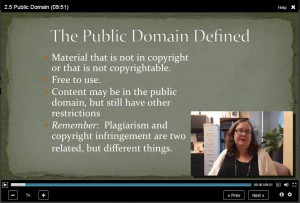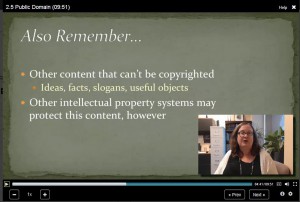
In this information age, many of us worry about others sharing pieces we have written, scanned, or recorded. What we may not consider, but should, is whether we ourselves have the right to use, donate, or sell certain items.
Recently, I participated in a four-week online course on copyright (for teachers and librarians) via Duke University. Meanwhile, my colleague Sally Benny attended a two-day education session during the Society of American Archivists (SAA) conference in Washington, D.C. Admittedly, neither of us expected the topic of copyright to hold much interest, but we rightly predicted the value of the information. It turns out that the basics of U.S. copyright law hold implications we had not realized.
Generally, “original works of authorship fixed in any tangible medium of expression” are protected by copyright. Holding copyright ownership means that you have the exclusive right to copy, make derivatives, distribute, perform, and display the work. Of interest to me was the fact that ideas, facts, and discoveries (among other things) are not copyrightable.
 With genealogy being so fact-driven, what does that mean for us? Essentially, when I write, “John Adams married in Weymouth, 25 October 1764, Abigail Smith,” I do not own that information; anyone can use it. However, if I compose a biography with (what my instructors called) “a spark of human creativity,” I could own copyright on the work as a whole. The individual fact would still be public, but if someone copied enough of my text, legally I could pursue compensation.
With genealogy being so fact-driven, what does that mean for us? Essentially, when I write, “John Adams married in Weymouth, 25 October 1764, Abigail Smith,” I do not own that information; anyone can use it. However, if I compose a biography with (what my instructors called) “a spark of human creativity,” I could own copyright on the work as a whole. The individual fact would still be public, but if someone copied enough of my text, legally I could pursue compensation.
Another angle to consider is that of physical versus intellectual ownership. Sally found this concept especially important concerning manuscripts. The donors often sign over both forms of ownership so NEHGS can display and even digitize the collection. Sometimes, the donors do not realize that they may not actually have the right to do so. Just because someone owns an item (like a manuscript), it doesn’t mean that person owns the copyright. The owner of the copyright is usually the author(s), heir(s), or employer(s) (in works for hire). That copyright ordinarily remains long after the death of the author. Currently, all unpublished works created before 1894 and works published before 1923 have entered into public domain and are free of copyright. Later works usually require permissions from the copyright owners or exceptions to copyright law.
Our classes emphasized using a framework to analyze whether a work is protected by copyright, and if so, whether that work can still be reproduced and/or distributed. I encourage everyone to carefully consider copyright when using materials you didn’t create or when making available those you created.
Interesting…. More please! And/or some layman’s references on this topic maybe? Tnx
I think this needs further discussion regarding copying materials that appear to be out of copyright, but are being sold on a website. For example, a newspaper article written in 1850, but requires a subscription to access on a website. I attended a lecture at a genealogy conference where the speaker mentioned that the images from their subscription website could not be publicly displayed in an online tree, because it was under the website’s copyright. This was a big surprise to me, because I had never thought about it.
You are completely correct – and we all need to be reminded of this. I wonder though about the use of items within copyright for simply personal use? It’s my humble experience that what data I make use of from copyrighted sources never really leaves my bookshelves. I may e mail a copy of something to a relative or a friend that is within copyright status, but what happens with or to it from that point is anybody’s best guess. Believe me, I’m not trying to shirk my responsibility for having respect or these items, I’m only trying to find the happy medium of how I can maintain them and give them the consideration due for my own “mainstream’ use.
It’s tough too with the web out there – realizing that we shouldn’t just grab onto something that is copyrighted is tough to do when we are looking to “fill in the blanks” on some long lost line of our hard fought for ancestral tree. I guess the best we can do at this point is acknowledge ownership, cite, and move on??? Beats me!?!?!
I do appreciate your post Kyle – this is a subject we all need to be well aware of and keep in the back of our minds as we compile our work.
Kudos to you for this!
Sincerely,
J. Record
One of my gg grandfathers wrote a book which he privately published, in serial format, beginning in the 1860s. I located a copy in the LOC, and a librarian there, after a search, told me it was the only copy she could find in any library. It had not been checked out internally in several years, but for some reason had recently been rebound, so was in good condition. She suggested I ask for it through ILL. I did, and a few weeks later had a thick volume my ancestor had written. It had no indication anywhere that he’d copyrighted it. And it would have been out of copyright in any case. So the family made copies for each sibling, and one for a 3rd cousin I’d found online. I believe I’m the only one who actually read the theological tome–he was a minister. It gave me some great insights into his thought processes, and included some wonderful genealogical nuggets I don’t think I’d have found anywhere else. I’ve been very careful when I cited it in my genealogical program, and that’s the only use I’ve made of it so far. Eventually, I’d like to write, for family use only, a bio of this very interesting man. He belonged to four denominations during his life, was a minister in three of them, and served as a missionary to Liberia. I certainly hope I’m making proper use of copyright law! So I too would appreciate more information on the subject.
Thank you so much. I have been scouring the Internet and calling people trying to get information on copyright. I am looking for not only information on how to copyright what I’m working on but what if I want to use images ephemera maps in my work how do I know if the things I’m collecting or in the public domain? For example maps — I just bought a Rand McNally atlas from the 1800s but Rand McNally still exists as a company. Am I free to use those images /maps because they were published before 1923? Do I have to pay a royalty?What is the difference between public domain and creative Commons? Yes one is concerned with whether or not an image or object is available for reuse and is no longer in to copyright and the other one is a type of copyright or non-copyright that is applied to something that you are working on How does that affect whether or not I can use items? I know there are a lot of websites now that have images I can download, buy and/or use from libraries the Metropolitan Museum of art etc. but are there still royalties even though the images are in the public domain? I have bought a lot of vintage and antique postpartum and wonder if I am free to use those? I have seen websites that have royalty free stock heart would charge for their images of etchings and artwork that is in the public domain? So I have gone and found the original art in the original first edition of the books I bought them for myself with the thought that since my book is a first addition I don’t have to pay a royalty to the stock house for a copy of the image the phone because I making my own photo or scan. I assume this is appropriate.
I would really love it if there was a book on the subject though I know it will change radically from year to year given Digital an online media is changing things almost overnight and constantly.
Here in New York there’s an organization called volunteer lawyers for the arts. They used to publish such books but they don’t have anything published currently that is useful to people riding family histories and using historic sources of camera and maps
Some of the public domain images I want to do use are in old books and publications I see these images for sale by stock houses who carry images of royalty free work but he charge for the use of those images. I assume it’s because they’re really charging for the use of a photo that they took and have turned into a digital image. So I have gone and found the first edition copies of the same books and ephemera and made my own scans and copies so that I would not have to pay royalties & a lot of agreements This brings up the question of whether not this will work as a way I can get images and use them freely.
So I am thrilled to see your article and hope you will write many more with lots more information. I will be watching for your next installment
Many thanks this is a great start Sam